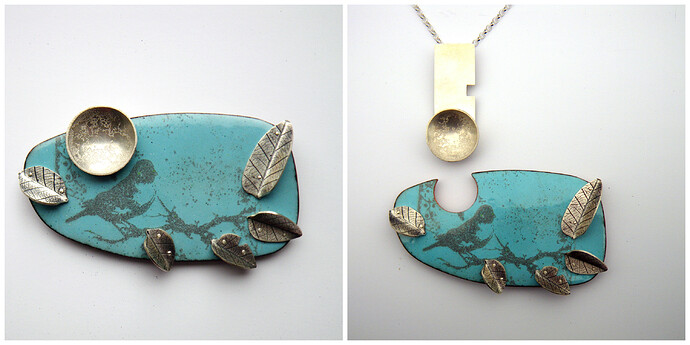Materials: Copper, enamel, silver, steel
Dimensions: 90mm x 40mm
A brooch from which the 'moon' can be extracted and used as a spoon or worn round the neck.
Photo credit: Cari-Jane Hakes
Cari-Jane Hakes
Jewellery by Cari-Jane Hakes
Elloughton, East Yorkshire. UK
Cari-Jane Hakes learned how to design whilst training as an Architect at Bath and Cambridge University, England. Whilst learning how to design buildings and bridges she became fascinated with the details that scale these pieces down to the size of a human hand - a door handle, a handrail, a window reveal.
She began to learn the discipline of goldsmithing at Morley College, London in 2005. She released her first collection in 2007.
Her designs draw on her architectural work, works of literature (in particular Italo Calvino) and historical myths and stories employed by northern native tribes and clans.
She works in series, abstracting these themes into wearable sculptures.
Her work has been published by Lark Books and exhibited online. Most recently, her work was accepted by Cortland Dewitt and Sharon Massey for Supbrooch 2013.
The exhibition explores metal works whose primary theme is color embraced as their primary visual focus, whether that be using colored materials, exploring creating colored surfaces, or encasing the object in color.
As the world's largest jewelry related internet site, Ganoksin strives to develop exhibitions showcasing work from around the world. This exhibition was open to all metalsmiths, professional and amateur, advanced and beginner.
In total 303 artists contributed 814 show pieces for the permanent online exhibition.
The exhibition was curated by Beth Wicker, President of the North Carolina Society of Goldsmiths in the United States, and Adjunct Instructor at Northeastern Technical College in South Carolina. Director of the exhibition is Hanuman Aspler, founder of The Ganoksin Project, the world's largest internet jewelry site.
Hue is one of the primary properties of color, it refers to the place the color occupies on the visual spectrum. Humans have used hues throughout time, to create cave paintings, to decorate themselves, their clothing and their housing.
Different hues have taken on different meanings throughout time. Gold traditionally has been a color of purity - the metal gold is relatively unchangeable, and the hue of gold has come to stand for gods and goddesses, for royalty, for durability and for purity. Red has often meant love, or passion. Hues often reflect the meaning of the seasons, with pastels referring to spring and the burst of new life after the pale hues of winter. Summer is reflected in vibrant, deep hues, followed by the browning of hues in the fall as plants go to seed and die, and the land turns fallow.
The worth of a hue has often been tied to what is necessary to make the pigment that creates the hue, and the expensive involved in the process. Often created from crushed stones that had to be mined and carried by caravan over thousands of miles, or from fermented roots of plants only grown in certain areas, or the carapaces of rare insects - the creation of hue in a way that could be used by man was an involved and generally expensive process.
In today's world metalsmiths have access to perhaps the widest range of materials and hues in the history of man - and in some of the most affordable ways ever.
This exhibition celebrates hue - color - as an integral, inherent element of the work. We talk of the "richness" of color, and examples of this abound here. One expects hues from the colors of gemstones used in metalsmithing, but we also have hues from some less expected places. Glass enamels are an ancient way of adding color, as are a variety of patinas. Today's artists also use synthetic man-made materials to add color in ways that didn't exist a century ago.
We invite you to enjoy this celebration of hue, and the ways hues and their use have changed over time.
